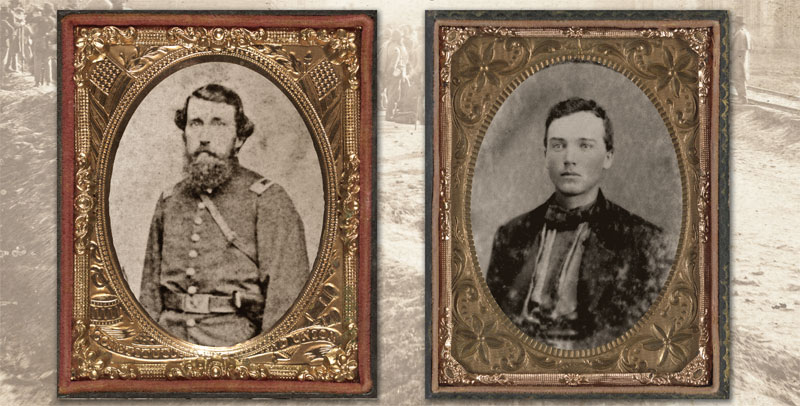An education interrupted by the Civil War
By Fred Brown
While the nation enters its third year of commemorating and reflecting upon the Civil War’s sesquicentennial, anyone interested in the University of Tennessee’s role in the conflict will find both treasures and dry holes of information.
Bluntly speaking, there is some information contained in early UT history accounts; there are precious letters in Special Collections and Archives; there are aging photographs on the walls in the offices of the Army ROTC.
But there is just enough that confounds, provides more questions than answers and whets the appetite at the same time. Despite having few individual records on those students who fought in the war, since most of the records were destroyed when buildings were damaged in the battles, there are some jewels of information.
Such is the story of John M. Brooks and Edward Maynard.
As it sometimes happens for young men whose nation comes calling, it was a time of decision. The year was 1861, and war was unleashed in America. These two young men were caught in that maelstrom.
Brooks hailed from a family of pioneers and patriots of the Revolutionary War. Maynard’s father, Horace, was an esteemed attorney, former professor of mathematics, rhetoric and belles lettres at East Tennessee University (which later became the University of Tennessee), and was first elected to the U.S. Congress from East Tennessee in 1857.
War Seemed Inevitable
In 1859, words of war scorched the air, placing the nation, state and region in a house evermore divided politically, perhaps more so than any other time in history. The possibility of war between states seemed inevitable. In the South, it was a foregone conclusion, though some cooler heads did attempt to lower the flames.
Brooks, Maynard and other young men came of age in perilous times. Like Brooks, some entered East Tennessee University, despite the prospects of the overwhelming divisions in society and political structures.
Within the next year, the nation would be convulsed in a contentious presidential election that would propel Abraham Lincoln into the White House and see 11 Southern states secede from the Union one after the other beginning in December 1860, assuring conflict.
Maynard began his education at East Tennessee University the year before Brooks, according to information found in early UT catalogs. But, by the spring of 1861, with Lincoln in the White House, Civil War erupted with the firing by Confederates on Union-occupied Fort Sumter in Charleston Harbor.
Brooks and Maynard, along with most of the other male East Tennessee University students, headed for the battlefields and an uncertain future in the spring of 1861. The students fairly epitomized the great disunion not only in the state but the region and nation as well.
Their college educations on hold, Brooks, whose grandfathers fought at the Battle of Kings Mountain in America’s Revolutionary War, and Maynard, whose father, Horace, was a current congressman, donned military uniforms.
The First Commandant of the University
Brooks, a freshman, and Maynard, a sophomore, had been part of a larger military presence at the university. In fact, Brooks is credited in some historical accounts as having started the university’s first two military companies.
Stanley J. Folmsbee, a former UT professor of history, wrote in his early accounts of the university that Brooks “organized a company of thirty to forty students, who were supplied with gray uniforms at the tailor shop of Knoxville’s future mayor, Peter Staub. The catalog for 1860-61 listed Brooks, with the word Student in brackets after his name, as ‘Instructor in Military Tactics.’”
“Thus he became the first commandant of the University. As later recalled by Brooks, in the spring of 1861 most of the men who were in his companies left to join the armies, some, such as Edward Maynard, the Union army, but most of them the Confederate forces.”
However, officials of UT’s Army ROTC point to 1844, when “Professor Albert Lea Miller, a West Point graduate, organized an Infantry Company, and a uniform for the cadets was adopted.” For the ROTC, Miller is the actual beginning of the military on the university campus.
In a wall of photographs of former Army ROTC cadet commanders, however, the frame for Miller’s photo is empty, while Brooks’ era-photograph is first for modern ROTC students to see.
No records exist that can definitively identify either Miller or Brooks as the originator of the military department. In fact, because of the Civil War and damage done to the university, records from about 1861 to 1866 are either missing or scarce.
The Battle of Fort Sanders
Folmsbee says university buildings were occupied first by Confederate troops and then by Union forces. By February 1861, a Confederate unit was bivouacked on the Hill. The campus was already deserted.
Some aspects of the Battle of Fort Sanders in November 1863 played out around or near the university. The campus suffered from shot and shell, which wrecked buildings, dug up the grounds with long, scar-like trenches and holes from artillery blasts. The Hill was at an elevation of 160 feet, making it an excellent choice for artillery.
Departure of students and the clamor of war in Knoxville forced the closing of the college, which became the University of Tennessee after the war.
Folmsbee also writes that, in the summer of 1861, “Although the war was already in progress and Tennessee was officially a part of the Confederacy, plans were made for the re-opening of the University for the next term.”
That reopening, however, didn’t take place until after the war’s end.
The 1859-60 catalog is the last one produced by the college before hostilities broke out across the nation. Publication of the catalogs did not resume again until the 1869-70 edition.
The 1859 catalog also lists East Tennessee University freshman John B. Simmons from Mt. Willing, La., as being killed in Seven Pines, Va., on May 31, 1862, a conflict connected to the larger Peninsula Campaign of Lincoln’s Army of the Potomac commander Maj. Gen. George McClellan.
A handwritten note beside his name in that catalog says Simmons, a private, was in the “6th Alabama right,” meaning the 6th Alabama regiment was on the right flank of the main battle line at Seven Pines. Simmons died in that first day of battle, the first time the 6th Alabama had tasted combat.
The catalog also has an asterisk by both Brooks and Simmons, indicating they had “some studies to make up.”
Alesha Shumar, University of Tennessee archivist, says it is presumed that catalogs and information, including graduation lists, about the college during the years 1860-69 were either lost or destroyed in the war.
“We don’t have commencement records of that time period,” Shumar says. “The way we are piecing together our commencements is if someone from that time period has handed them down and then the family donates them to us.”
Brooks, about 21 at the time, went off to fight with Confederate Col. Henry Ashby’s 2nd Tennessee Cavalry. Maynard, who was right about the same age, joined the Union’s 6th Tennessee Volunteer Infantry. He later became a lieutenant colonel of the 6th.
The Prime of Life
Here were two young men in the prime of life and caught in the whirlwind of war as it swirled around the campus, which was quite small at the time.
That smaller campus population might explain why it is difficult to find out very much about the students, unless they were part of a very prominent family. The entire school population was from 20 to 30 students in those pre-war years.
Brooks was listed as living in Room 36 in the East Hall, and five doors away was Maynard at 41 East Hall.
Brooks and Maynard saw a great deal of action during the war. Brooks is credited in his obituary in the Confederate Veteran publication of 1922 as having a lengthy combat record.
Capt. Brooks was in “Company I, 2d Tennessee Cavalry, under Colonel Henry M. Ashby,” the obituary claims.
“The greater part of the time he was with the Army of Tennessee, but he also saw service in Kentucky, Virginia, North and South Carolina, Georgia, Mississippi and Alabama.
“Captain Brooks was in the battles of Chickamauga, Fishing Creek, Murfreesboro, Shiloh, Perryville, and Richmond, Ky. At Chickamauga he was dangerously wounded and nearly died; but after twelve months in the hospital he recovered and rejoined his company. He then served for some time on Colonel Scott’s staff and did scout duty for Gen. Joe Wheeler. He surrendered near Charlotte, N.C., in the spring of 1865.”
A history of the 6th Infantry credits Maynard with a sterling combat record as well.
Soon after joining the federal’s 6th Tennessee Infantry, Maynard was promoted to lieutenant colonel and was attached to the 23rd Army Corps.
Maynard’s regiment was at the Battle of Murfreesboro, engaged the enemy near Lost Mountain, Ga., in June 1844 and took part in the Battle of Nashville.
He escaped unscathed and was mustered out in March 1865.
Neither Brooks nor Maynard returned to their academic careers at East Tennessee University after the war. Or, if they did, there is no existing record.
After the war, Maynard held a minor position in the secretary of state’s office in Nashville. In May 1866, he was appointed as consul to the Turks Island, at the time a British-held island north of Cuba and Hispaniola. His two years in the tropics ended tragically.
On Feb. 7, 1868, Horace Maynard and family learned of his death from yellow fever.
After the war, Brooks served as mayor of Middlesboro, Ky., and was mayor of Knoxville from 1908-10. He also married into the prominent Park family of Knoxville.
Even though it is not clear whether Brooks earned a degree from the university, his family maintained a relationship with the school.
University buildings were so badly damaged that the federal government, through the influence of Horace Maynard, issued a grant of more than $18,500 to help in the repairs.
Previously, Horace Maynard had worked to have Congress award $4,144 to help compensate for building repairs, but that grant was vetoed by President Ulysses S. Grant.
The president said he feared that, if the money were paid to East Tennessee University, others, especially in the heavily damaged South, would want war-time reparations.
So, federal money to repair the damaged and destroyed buildings didn’t arrive until almost a decade after the war.



